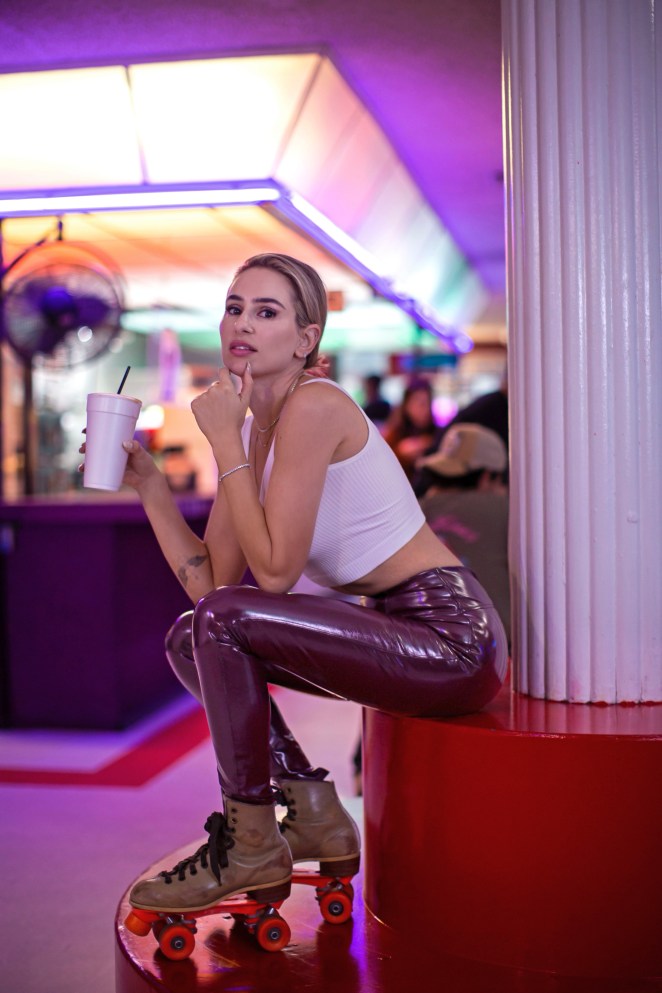Tied to the pulse of Depeche Mode’s 1987 hit “Behind the Wheel,” Elena Charbila (Kid Moxie), became fixed on the idea of some things Better Than Electric. Writing during the pandemic, “Better Than Electric” would become the title track of her new album and guide the remaining 13 tracks steered by love and lust, and driving in the dark.
Videos by American Songwriter
“When I first wrote the first song ‘Better Than Electric’ I liked the title and the feel of that song so much that I wanted to keep recreating it in different sort of formats, because it kind of encompassed all the things I really cared about, and still care about, which is night drives, Los Angeles, sex, love,” says Charbila. “All of those themes fit in this retro-futuristic sonic backdrop.”
For Charbila, who recently worked with longtime David Lynch composer Angelo Badalamenti on a cover of “Mysteries of Love” from Lynch’s 1986 film Blue Velvet, and has composed for television, video games, and film, including her most recent soundtrack to 2020 Giorgos Georgopoulos-directed film Not to be Unpleasant, but We Need to Have a Serious Talk, Better Than Electric was an accidental album.
“It wasn’t planned,” jokes Charbila. “It’s like a pregnancy that you just don’t didn’t plan for, but you keep the baby.”

Originally written about a long-distance relationship, “Better Than Electric” (featuring British electro artist Maps on the album), continued to shape-shift into something more palpable and cinematic. “It had like this neon feel because of the synths,” adds Charbila, “so I kept recreating the same song with very different sounds with the same kind of feel, then I thought ‘I guess this is going to be an album now.’”
As she was writing the lyrics to “Better Than Electric,” Charbila knew she wanted to include the word electric since it has so many different meanings for her. “It’s the synth world, which I’m obsessed with, but it’s also immersive,” she says. “It’s a very emotionally charged thing that we use for love and for connection. Electricity is just an alluring concept, not just sonically but emotionally as well. It’s like a surrealistic pairing of words.”
Produced by Charbila, who is also an established composer, Better Than Electric free falls around desires from the scandal-ridden synth of “At the End of the Night” and the bolstering open of “Shine,” co-written and produced by electronic artist Faderhead, who also worked on the track “Unbroken.” Inspired by another Depeche Mode Music for the Masses-era song “Never Let Me Down Again,” “Shine,” set around its lyric I’m taking a ride with my best friend, sets forthcoming scenes of Better Than Electric.
“It starts with that concept but it became more sinister,” says Charbila, who sings I’m taking the lead in the back seat… I’ll show you something you don’t know you like on the track. “I wanted to make this about best friends, two girls, who end up having sex in the backseat and put a twist on it.”
All of Better Than Electric is made up of themes that Charbila cared enough to flesh out in sound and vision, evident in her neon-dashed music videos. “Music doesn’t walk its own path,” says Charbila. “We’ll always have a connotation or a stimulus. We always get stimulated visually and emotionally by what we hear. Being a control freak, I try to put out what it [the music] means to me visually.”
Caught between the light and night time, the well-behaved and the risqué, Better Than Electric is calculated in its moves and plays as an epic 1980s soundtrack, stemming from the darkened synth-pop of Berlin, Yaz, and The Human League, playing off the tender chimes of “Thunderstruck” and “On a Sunday Night”—the latter conceived during one late night drive in LA—through the house music beats of “Miss Robot” and rave-induced “Odyssey” and “Lost in Time.”
For four tracks, Charbila added remixes from Die Arkitektt (“Shine,” Odyssey”), Frankin (“On a Sunday Night”), and Dimitris Papaspyropoulos, who produced a Last Chance remix of the title track.
Unlike her other compositions or scores, writing Better Than Electric was a more personal endeavor for Charbila. Now based in Los Angeles, the artist left Greece in her teens to study in San Francisco and later worked as a musical accompanist to Michael Bublé and later found her alter-ego after discovering a can of Moxie Cola.

“When I do my own stuff, I know immediately the sounds and the feel that I’m going towards,” she says. “I’m piecing the puzzle as I go, and it’s only really filtered through me. It’s not filtered through a director or visual board that somebody else has created. It’s more of an immediate thing.”
The common thread between both, whether it’s a film or media or whether it’s my own thing, is that it’s something I really believe in first,” says Charbila. “The first thing that comes out is more powerful than when you overthink it or keep going over it, because your mind starts getting very involved in the writing process and it ends up coming from someplace other than your gut.”
Right now, everything is in sync for Charbila with this collection of songs. Everything is electric.
“This album is as close to my emotional and sonic sensibilities as can possibly be,” says Charbila. “It’s a blending of everything I love to listen to, every song is a cinematic scene, and the lyrics are there to ideally serve the picture.”
Photo: George Tripodakis / Falcon Publicity
